Click on images to enlarge
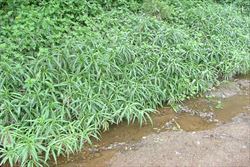
infestation along a creek (Photo: Sheldon Navie)

infestation in a swampy grassland (Photo: Sheldon Navie)
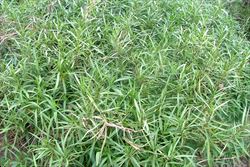
habit (Photo: Sheldon Navie)
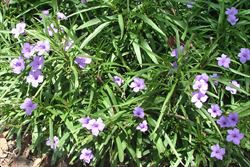
habit in flower (Photo: Sheldon Navie)

four-angled stem and bases of paired leaves (Photo: Sheldon Navie)
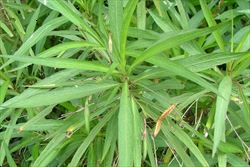
elongated leaves (Photo: Sheldon Navie)

close-up of slightly broader lower leaves (Photo: Sheldon Navie)
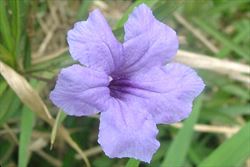
close-up of flower (Photo: Sheldon Navie)
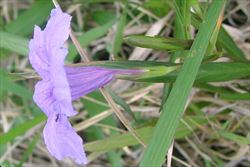
tubular flower from side-on (Photo: Sheldon Navie)

immature fruit (Photo: Sheldon Navie)
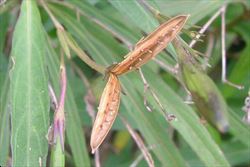
mature fruit that has released its seeds (Photo: Sheldon Navie)
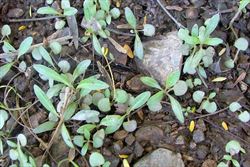
seedlings (Photo: Sheldon Navie)
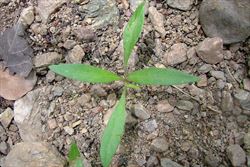
young plant (Photo: Sheldon Navie)
Scientific Name
Ruellia simplex C. Wright
Synonyms
Ruellia brittoniana Leonard
Ruellia caerulea Morong
Ruellia coerulea Morong, orth. var.
Ruellia malacosperma Greenm. (misapplied)
Ruellia tweediana Griseb.
Family
Acanthaceae
Common Names
Britton's wild petunia, creeping ruellia, Mexican bluebell, Mexican petunia, ruellia, wild petunia
Origin
Native to Mexico and South America (i.e. south-eastern Brazil, Bolivia, Argentina, Paraguay and Uruguay).
Cultivation
Mexican petunia (Ruellia simplex) is sometimes cultivated as a garden plant (i.e. ornamental).
Naturalised Distribution
This species has become widely naturalised in the warmer parts of eastern Australia. It is widespread in the coastal districts of Queensland and is also becoming naturalised in the coastal districts of northern New South Wales.
Also naturalised overseas in south-eastern USA (i.e. Texas, Louisiana, Mississippi, Alabama, Georgia, South Carolina and Florida), Hawaii, Central America (i.e. Belize) and the Caribbean (i.e. Puerto Rico and the Virgin Islands).
Habitat
A weed of waterways, riparian vegetation, dams, ponds, wetlands and drainage ditches in sub-tropical and tropical regions.
Habit
An upright (i.e. erect) and long-lived (i.e. perennial) herbaceous plant with several stems growing up to 1 m tall.
Distinguishing Features
- an evergreen perennial, herbaceous plant growing up to 1 m high.
- it produces several stems from a single rootstock and the older stems may be slightly woody; the younger stems are mostly hairless, green and four angled (quadrangular).
- its simple leaves are carried in opposite pairs on the stem; each leaf has a short stem (petiole) 1-2 cm and the leaves are long and narrow (up to 20 cm long), hairless and usually dark green or slightly purplish tinted; the leaf tip is pointed and the leaf margins are even.
- its tubular flowers are lavender or purplish in colour, but white forms are known.
- its club-shaped fruits (up to 25 mm long) are at first green or purplish green; when ripe, they turn brown and then explosively release the seeds.
Stems and Leaves
The older stems are often slightly woody, while younger stems are green and four-angled (i.e. quadrangular). These youngers stems are hairless (i.e. glabrous) or sparsely hairy (i.e. puberulent), but often have more prominent tufts of hairs at their jointed (i.e. nodes).
The oppositely arranged leaves are borne on short stalks (i.e. petioles) 1-2 cm long. These leaves (6-20 cm long and 4-20 mm wide) are long and narrow in shape (i.e. linear) with entire margins and pointed tips (i.e. acute or acuminate apices). They are mostly hairless (i.e. glabrous) and usually dark green or slightly purplish-tinged.
Flowers and Fruit
The flowers are borne in few-flowered clusters in the upper leaf forks (i.e. in axillary cymes). These flowers are tubular in shape and lavender, blue or purplish in colour. They have five narrow green sepals (5-10 mm long) at the base and five petals (2.5-4 cm long) that are fused for most of their length into a tube (i.e. corolla tube). The petals separate into five spreading lobes with rounded tips (i.e. obtuse apices). Each flower also has four stamens and an ovary topped with a style and stigma.
The club-shaped (i.e. clavate) fruit are capsules that are green or purplish-tinged when young. These fruit (2-2.5 cm long) turn brown in colour and explosively release their seeds when fully mature.
Reproduction and Dispersal
This species seeds profusely and also reproduces vegetatively via creeping underground stems (i.e. rhizomes) and stem segments.
Its seeds are spread short distances when they are explosively released from the mature fruit. They may also be spread in water, externally on animals and in dumped garden waste. Colonies spread laterally via their creeping underground stems (i.e. rhizomes) and stem segments may be dispersed by water during floods and in dumped garden waste.
Environmental Impact
Mexican petunia (Ruellia simplex) is regarded as an environmental weed in Queensland and is of particular concern in the south-eastern parts of this state, where it was recently ranked among the 200 most invasive plant species. For example, it is listed as a significant non-declared pest plant in Maroochy Shire, an undesirable plant in Caboolture Shire, and a weed of natural bushland and waterways in Gold Coast City.
In the last 20 years, Mexican petunia (Ruellia simplex) has gone from being relatively uncommon to being one of the most common and widespread species in Brisbane's waterways. It often forms dense monocultures in wetter sites, particularly along creekbeds and on creekbanks. Such infestations prevent the natural growth and regeneration of native riparian plants (e.g. Backhousia myrtifolia, Glochidion ferdinandi, Waterhousea floribunda, Carex spp. and Callistemon spp.), and unlike some other riparian weeds it will grow in shady creeks.
Mexican petunia (Ruellia simplex) has also become invasive in south-eastern USA, where it has spread rapidly and displaced native flora. It is proving especially problematic in wet areas and can out-compete closely related native species in such environments (e.g. Ruellia caroliniensis). Because of this, it has been listed as a Category 1 invasive pest plant by the Florida Exotic Pest Plant Council.
Legislation
Not declared or considered noxious by any state government authorities.
Management
As this species is not a declared plant, its control is usually not required and there are no restrictions on its sale or cultivation. However, it is a serious environmental weed and should be managed in sensitive waterways and conservation areas.
Similar Species
Mexican petunia (Ruellia simplex) is very similar to minnieroot (Ruellia tuberosa) and relatively similar to creeping ruellia (Ruellia squarrosa). These species can be distinguished by the following differences:
-
Mexican petunia (Ruellia simplex ) is an upright plant (growing up to 1 m tall) with long and narrow (i.e. linear) leaves that are mostly hairless (i.e. glabrous). Its tubular flowers have five small narrow sepals (5-10 mm long).
-
minnieroot (Ruellia tuberosa ) is an upright or creeping plant (growing up to 0.5 m tall) with relatively broad (i.e. elliptic to ovate) leaves that are mostly hairless (i.e. glabrous). Its tubular flowers have five large narrow sepals (18-30 mm long).
-
creeping ruellia (Ruellia squarrosa ) is a creeping plant (less than 0.5 m tall) with slightly elongated (i.e. ovate to narrowly-ovate) leaves that are hairy (i.e. pubescent). Its tubular flowers have five small narrow sepals (10-16 mm long).
Notes
Mexican petunia (Ruellia simplex) is regarded as an environmental weed in Queensland and is of particular concern in the south-eastern parts of this state, where it was recently ranked among the 200 most invasive plant species. For example, it is listed as a significant non-declared pest plant in Maroochy Shire, an undesirable plant in Caboolture Shire, and a weed of natural bushland and waterways in Gold Coast City.
In the last 20 years, Mexican petunia (Ruellia simplex) has gone from being relatively uncommon to being one of the most common and widespread species in Brisbane's waterways. It often forms dense monocultures in wetter sites, particularly along creekbeds and on creekbanks. Such infestations prevent the natural growth and regeneration of native riparian plants (e.g. Backhousia myrtifolia, Glochidion ferdinandi, Waterhousea floribunda, Carex spp. and Callistemon spp.), and unlike some other riparian weeds it will grow in shady creeks.
Mexican petunia (Ruellia simplex) has also become invasive in south-eastern USA, where it has spread rapidly and displaced native flora. It is proving especially problematic in wet areas and can out-compete closely related native species in such environments (e.g. Ruellia caroliniensis). Because of this, it has been listed as a Category 1 invasive pest plant by the Florida Exotic Pest Plant Council.
This fact sheet has been updated thanks to the sponsorship of Sunshine Coast Council.

